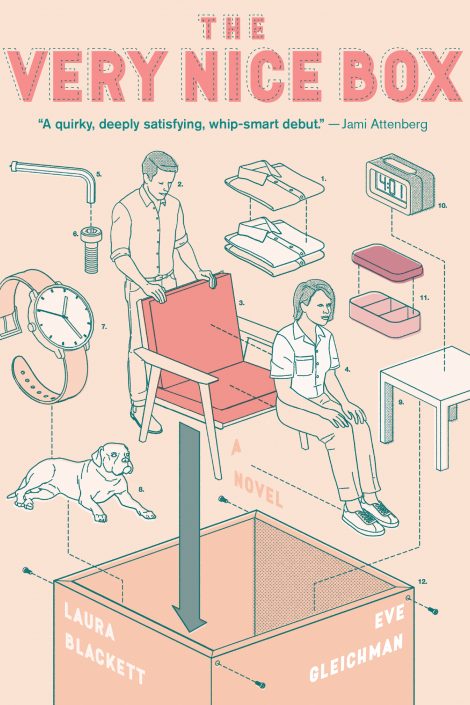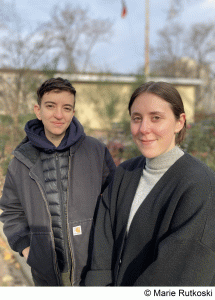
THE VERY NICE BOX
For fans of Elinor Oliphant Is Completely Fine and Severance: an offbeat, wryly funny debut novel that follows an eccentric product engineer who works for a hip furniture company where sweeping corporate change lands her under the purview of a startlingly charismatic boss who seems determined to get close to her at all costs . . .
Ava Simon designs storage boxes for STÄDA, a slick Brooklyn-based furniture company. She’s hard-working, obsessive, and heartbroken from a tragedy that killed her girlfriend and upended her life. It’s been years since she’s let anyone in.
For fans of Elinor Oliphant Is Completely Fine and Severance: an offbeat, wryly funny debut novel that follows an eccentric product engineer who works for a hip furniture company where sweeping corporate change lands her under the purview of a startlingly charismatic boss who seems determined to get close to her at all costs . . .
Ava Simon designs storage boxes for STÄDA, a slick Brooklyn-based furniture company. She’s hard-working, obsessive, and heartbroken from a tragedy that killed her girlfriend and upended her life. It’s been years since she’s let anyone in.
But when Ava’s new boss—the young and magnetic Mat Putnam—offers Ava a ride home one afternoon, an unlikely relationship blossoms. Ava remembers how rewarding it can be to open up—and, despite her instincts, she becomes enamored. But Mat isn’t who he claims to be, and the romance takes a sharp turn.
The Very Nice Box is a funny, suspenseful debut—with a shocking twist. It’s at once a send-up of male entitlement and a big-hearted account of grief, friendship, and trust.
- Houghton Mifflin Harcourt
- Hardcover
- July 2021
- 368 Pages
- 9780358540113
About Eve Gleichman & Laura Blackett
 Eve Gleichman‘s short stories have appeared in the Kenyon Review, the Harvard Review,Bomb Daily, and elsewhere. Eve is a graduate of Brooklyn College’s Fiction MFA Program and lives in Brooklyn.
Eve Gleichman‘s short stories have appeared in the Kenyon Review, the Harvard Review,Bomb Daily, and elsewhere. Eve is a graduate of Brooklyn College’s Fiction MFA Program and lives in Brooklyn.
Praise
“Laura Blackett and Eve Gleichman are linguistic magicians, and their sparkling debut manages to expose the hollowness of well-being jargon while exploring, with tender care and precision, how we dare to move on after unspeakable loss . . . [They have] constructed a mirrored fun house, one that leads us down different paths, each masterfully tied up at the end, yet reflecting and refracting our own quirky selves.” —New York Times Book Review
“A very funny debut — and perhaps the most original office satire of the year.” —Washington Post
“A quirky, deeply satisfying, whip-smart debut that critiques corporate culture and male entitlement while also offering a heartfelt look at how to work through grief. Meticulously constructed and truly original—I inhaled it.” —Jami Attenberg, author of All This Could Be Yours
“Eve Gleichman and Laura Blackett have managed to write a literary page-turner that is full of heart and scathing social critique, not to mention a surprise ending to rival those of my favorite mysteries. I absolutely devoured it.” —Melissa Febos, author of Girlhood
“A satire of contemporary corporate culture. An exploration of how vulnerable we become in grief. A surprising romance. A cautionary tale. Somehow The Very Nice Box manages to be all of the above. Eve Gleichman and Laura Blackett have a wicked sense of humor and a keen view on our current moment. This is a delightful and propulsive read.” —Helen Phillips, author of The Need
Discussion Questions
1. Consider how the authors employ satire. What does the opening of the story reveal about STÄDA and its culture? Did it feel familiar to you? How would you say that STÄDA compares to real-life businesses? What does Ava do at the company and why does she like working there? Alternatively, what does she try to avoid while she is there? As Ava stands in the Imagination Room for the announcement of Karl’s departure, she wonders “Am I in a cult?” (13). How would you answer her question?
2. What are Mat’s first interactions with Ava like and what are her first impressions of him? Why does Ava accept a ride home from Mat even though it was “the last thing [she] wanted” (24)? Were you surprised when she agreed to meet Mat at the dog park the following day?
3. How does STÄDA “demand” the so-called “self-care” of its employees? What is problematic about this? What does this say about the true nature of self-care and wellness and how they can best be cultivated? What alternative offering or solutions from STÄDA—and real-life businesses—might be better contributions to their employees’ actual health and wellness?
4. When Mat tells Ava about an email from Judith in which she chided him for being five minutes late to his job interview, Ava thinks “men got to be this way . . . constantly in the midst of forgiving themselves” (48). What do you think she meant by this? Do you agree with her? Where else does the book offer thoughts on male entitlement?
5. Explore the theme of grief. Years after the deaths of her parents and her fiancée, Andie, how are these losses still impacting Ava? What support does she have? What are some of her coping mechanisms? Do they seem to be effective? How does Ava’s grief influence her decision-making? What is—or could have been—most helpful for Ava as she attempts to reimagine her life after such enormous loss?
6. Evaluate the symbolism of the Very Nice Box. Why did Ava feel so passionate about this particular project? What do you think that the box represents for her? Why do you think the book was named after this object? How does it reflect or refer readers back to the major themes and motifs of the book?
7. What is Ava’s relationship with Jaime like? How does their relationship change once Ava begins dating Mat? What insights does Jaime offer into their relationship from an outside perspective and how does Ava respond to this? Would you say Ava is a good friend to Jaime?
8. Who are the Red Hook Vandals and why are they trying to stop the development of the Vision Tower? How does the book provide a counterpoint to the characterization of the Vandals? Why does a member of this group tell a reporter that it is ironic that STÄDA sees itself as the victim? Who are the Vandals revealed to be at the book’s conclusion and how does this tie in with contemporary conversations about activists and their portrayal in the media?
9. How do the authors create suspense within the story and how does this contribute to a conversation about the themes of trust and intuition? Were you surprised by Mat’s identity? Why or why not? What were some of the red flags that Ava ignored? What made her particularly vulnerable to Mat’s predatory behavior? What does the book ultimately suggest about who one should make oneself vulnerable to and how can people make good choices in this area?
10. What is it that Mat and Ava ultimately have in common? At the end of the novel, how has she been changed by her experience and what steps does she say that she wants to take in order to begin a true process of healing?
